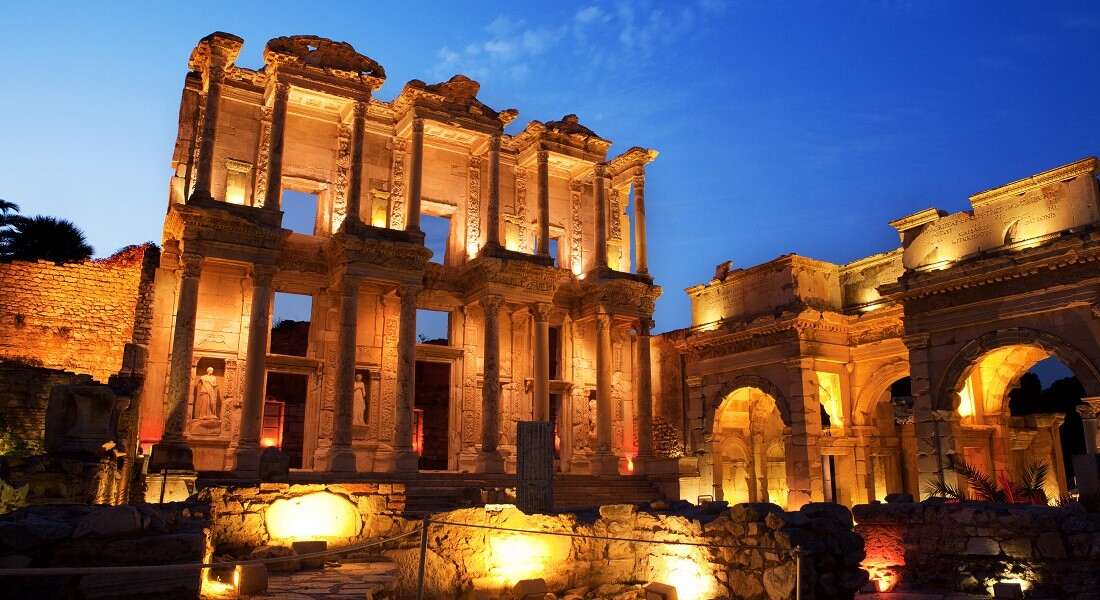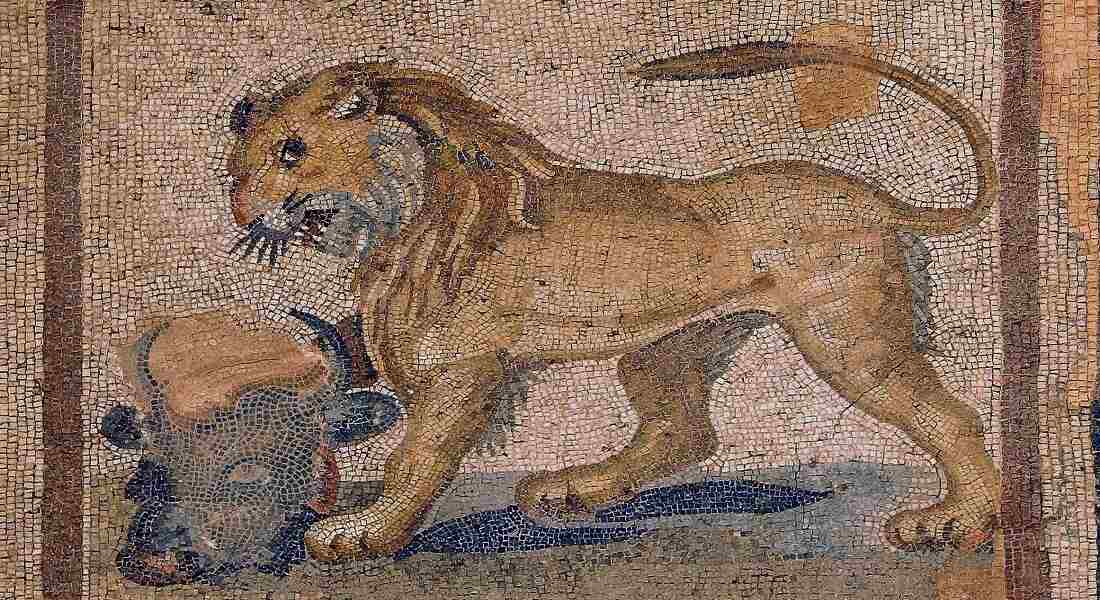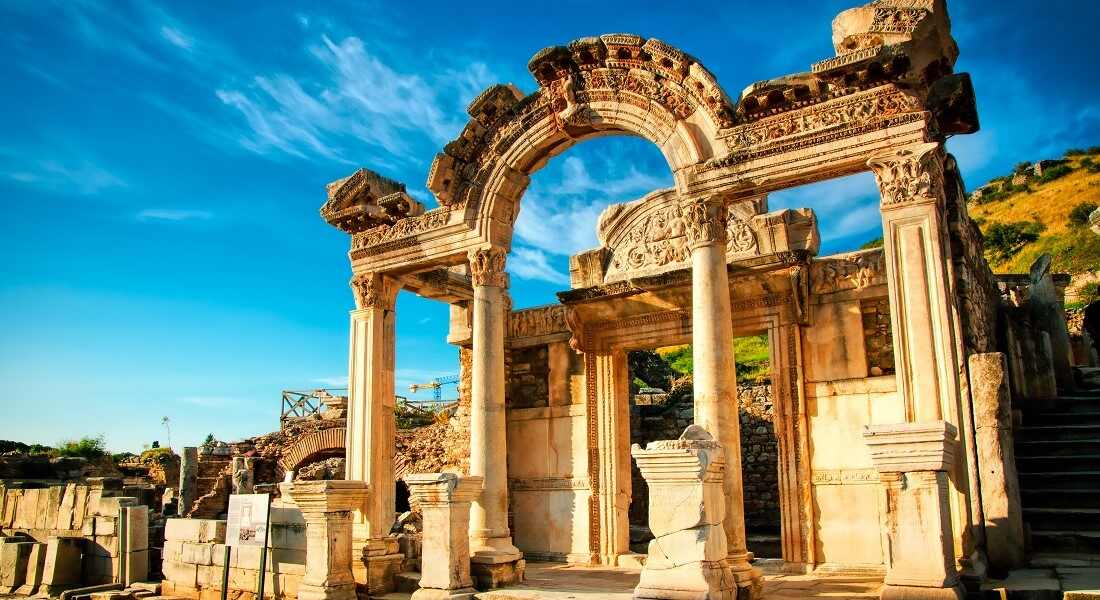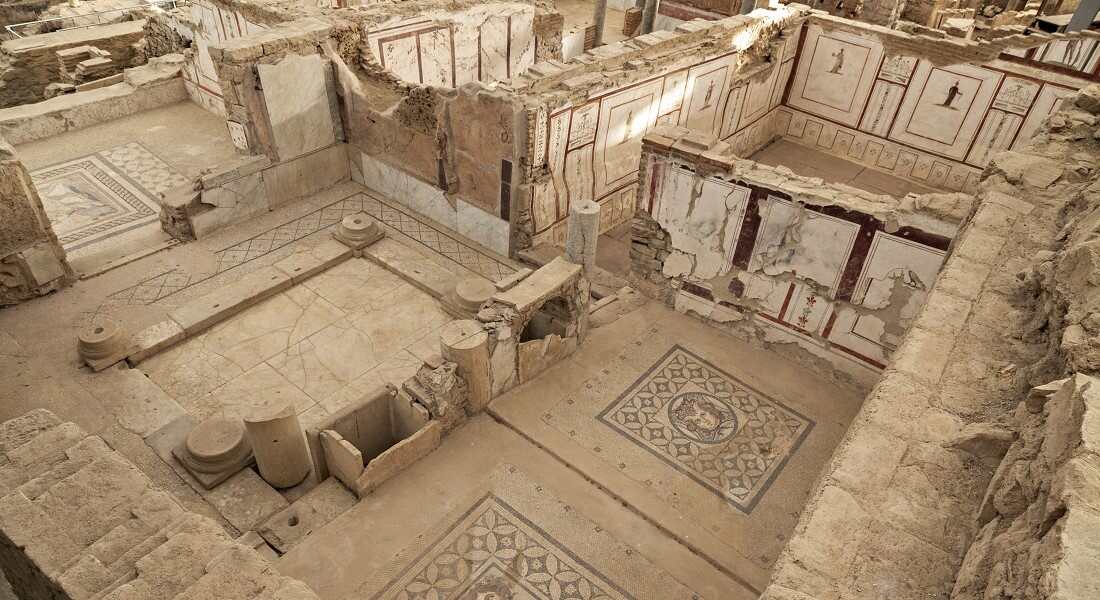
Ephesus was an ancient Greek and Roman city located on the western coast of modern-day Turkey. The city was established in the 10th century BCE and grew to become one of the largest and most prosperous cities in the ancient world. The city had a considerable impact on the history of the Mediterranean region. It was a major commercial and cultural center known for its port, markets, and famous landmarks such as the Temple of Artemis, one of the Seven Wonders of the Ancient World.
Ephesus was also an important center of religious activity, attracting pilgrims from all over the Mediterranean to worship at its temples and shrines. In addition, it was the home of the cult of Artemis, one of the most important deities in the Greek and Roman pantheon. Because of all these, UNESCO declared Ephesus a World Heritage Site in 2015.

Early History: In the 10th century BCE, the Ionian Greeks founded Ephesus. The city was near the coast and the mouth of the Cayster River, making it an important trading hub for goods from the east. The town also became known for its religious importance, as it was home to the cult of Artemis, a prominent Greek goddess. The temple of Artemis was one of the Seven Wonders of the Ancient World and is considered the most important temple in the region. It was a pilgrimage center and attracted visitors from all over the ancient world.
Hellenistic Period: Ephesus became a major center of learning and culture during the Hellenistic Period. The Seleucid Empire, the Pergamene Kingdom, and later the Roman Republic all ruled the city. The city was a central hub of trade and commerce, overgrowing in size and importance. The town was home to many notable figures, including the philosopher Heraclitus, who was born in Ephesus. The city also became known for its impressive public works, such as the system of aqueducts that brought fresh water into the city.
Roman Period: Ephesus reached the height of its power and influence during the Roman Period. The city was one of the largest and most prosperous in the Roman Empire and a major center of art, architecture, and philosophy. The town was home to several important monuments, including the Library of Celsus, the Temple of Hadrian, and the Great Theater. The Library of Celsus was one of the largest and most impressive libraries in the ancient world, containing thousands of books and scrolls. The Great Theater was one of the largest and most unique in the ancient world, and it could seat up to 25,000 people.
Byzantine Period: In the Byzantine Period, Ephesus continued to be an important center of religion and culture. The city became a major center of Christianity and was the site of several important churches and monasteries. The city also played a significant role in the Byzantine Empire’s struggle against the Muslim armies of the Arab Caliphate. In 654 CE, Arab armies sacked and burned the city. Still, later Christians rebuilt it, and the town became an important center.
Ottoman Period: During the Ottoman Period, Ephesus lost much of its former importance and fell into decline. As a result, the city was largely abandoned, and many of its ancient monuments were left to decay. However, in the 19th and 20th centuries, the town began to be rediscovered by archaeologists and tourists, who helped to restore and preserve its ancient ruins. The first excavations at Ephesus were carried out in the late 19th century by the British archaeologist John Turtle Wood. Then, the site was extensively excavated in the early 20th century by the Austrian archaeologist Otto Benndorf and his team, who uncovered many of the city’s most impressive monuments.

Ephesus’ significance as one of the seven churches mentioned in the New Testament is well-documented in historical records. Towards the end of the first century, after Christ, the Apostle John composed the Book of Revelation. It has letters to each of the seven churches in Asia Minor, including Ephesus. The city was already an important center of Christianity by this time, having been visited by other prominent figures in the early Church, such as the Apostle Paul. Paul spent more than two years in Ephesus during his third missionary journey. During this time, he established a solid Christian community in the city. This historical data demonstrates Ephesus’s important role in the early years of Christianity and reinforces its place as one of the most significant cities in the ancient world.

Temple of Artemis: People believed that the Temple of Artemis was a significant religious place that had existed and one of the Seven Wonders of the Ancient World. The temple was dedicated to Artemis, the Greek goddess of the hunt and the wilderness. It was constructed in the 6th century BC. Over the years, the temple was rebuilt several times; each time, it was bigger and better than the last. Unfortunately, the Goths eventually destroyed the temple in the third century AD, and it never recovered.
Library of Celsus: The Library of Celsus was built in the second century AD and was one of the most iconic buildings in Ephesus. Tiberius Julius Celsus Polemaeanus, a Roman senator and former governor of the province of Asia, was honored with the library. It housed a vast collection of books and scrolls. Unfortunately, the library was destroyed in a fire in the 3rd century AD. Nevertheless, the city was later rebuilt and restored it.
Great Theater: It was one of the largest and most impressive theaters in the ancient world and could seat up to 25,000 spectators. The theater was built during the Hellenistic Period. It was used for various performances, including plays, concerts, and gladiatorial contests. The well-known Ephesus riot, which broke out in the first century AD due to a group of silversmiths who were upset about the spread of Christianity, also took place there.
Church of Mary: The Church of Mary is among the most important Christian sites in Ephesus. It was dedicated to the Virgin Mary, who is said to have spent her later years in Ephesus. The Church was built in the 5th century AD and was one of the earliest Christian churches in the world. The Church was eventually abandoned in the 14th century AD but was rediscovered and restored in the 19th century.
The Terrace Houses: The Terrace Houses were a complex of luxurious homes built in the 1st century AD and occupied by the wealthiest citizens of Ephesus. The houses were built on a hill’s side and decorated with intricate mosaics, frescoes, and other artworks. The Terrace Houses were rediscovered and excavated in the 20th century and are now open to the public as a museum.

Ephesus was located on the Aegean coast of Asia Minor, at the mouth of the Cayster River, and extended from the beach to the mountains. The city was in the middle of many important trade routes, making it a business and culture center. The city was also strategically located near several other critical ancient towns, including Smyrna, Pergamon, and Miletus. In addition, the city was built on a series of hills, which gave it a natural defensive advantage. The mountain also provided a wild arena for the city’s famous theater, which could seat up to 25,000 people.
Ephesus had a Mediterranean climate, with hot, dry summers and mild, wet winters. The region received relatively little rainfall, which made irrigation and water management essential for agriculture. The climate also influenced the city’s culture and way of life, as the people of Ephesus were known for their love of outdoor festivals, theater performances, and other cultural events. The region was also rich in natural resources, including fertile land for agriculture, timber for building, and minerals for mining. The city was also located near the coast, which provided access to fish and other seafood. These natural resources were essential for the city’s growth and prosperity.

Ephesus was one of the largest cities in the ancient world, with a population that ranged from 250,000 to 500,000 people at its height. As a result, the city was a melting pot of different cultures and ethnicities, with people from Greece, Rome, Egypt, and other regions living side by side. In addition, the city’s location on essential trade routes made it a cosmopolitan hub of commerce and culture.
The social structure of Ephesus was complex and stratified. At the top were the wealthy elite, including merchants, landowners, and politicians. Below them was the middle class, which included skilled artisans, traders, and professionals. At the bottom were the lower classes, including enslaved people and laborers. Women in Ephesus enjoyed a higher status than in many other ancient societies, with some women even holding positions of power and influence.
Religion played a central role in the life of Ephesus, which was home to various religious traditions. The city was particularly renowned for its devotion to the goddess Artemis. Christianity also played a significant role in Ephesus, with the city home to one of the seven churches mentioned in the Book of Revelation. The city was also a center of Hellenistic and Roman religion, with temples dedicated to gods such as Zeus and Dionysus.
Ephesus was renowned for its art and architecture, which reflected the city’s wealth and cultural diversity. The town was home to many impressive public buildings, including the Library of Celsus, the Temple of Hadrian, and the Great Theater. The city’s private homes and villas were also known for their luxurious design and decoration, with intricate mosaics, frescoes, and sculptures. The city’s art and architecture demonstrate the high level of cultural achievement and sophistication present in ancient Ephesus.
Ephesus was home to several important learning centers, including the Library of Celsus and the famous School of Rhetoric. The city was renowned for its intellectual and cultural achievements, with many famous philosophers, writers, and scholars living and working in the city. In Ephesus, education was essential, and many parents put a lot of money into their children’s education. This focus on education helped to fuel the city’s cultural and intellectual growth, making it one of the most important centers of learning in the ancient world.

Ephesus was strategically located on the coast of the Aegean Sea, making it a natural center for trade and commerce. In addition, the city connected other major trade centers in the Mediterranean world, such as Rome, Athens, and Alexandria, through a network of sea routes. As a result, the city’s port was one of the largest and busiest in the ancient world, handling a wide variety of goods, including textiles, spices, precious metals, and luxury goods. Unfortunately, the city’s location also made it a center for the slave trade, with enslaved people being bought and sold in the city’s markets.
The surrounding region of Ephesus was rich in fertile farmland, allowing the city to produce a variety of agricultural products. The city was mainly known for growing grapes, olives, and figs used to make wine, olive oil, and other food products. The city also produced various crops, including wheat, barley, and vegetables, which helped feed the city’s growing population.
Ephesus was home to various industries, including textile production, pottery, and metalworking. The city was particularly renowned for its textile industry, which produced high-quality woolen textiles exported throughout the Mediterranean world. The city was also known for producing fine pottery, decorated with intricate designs, and sold to wealthy patrons. Metalworking was also a big business in Ephesus, and the city made things like weapons, tools, and jewelry out of metal.
Ephesus was one of the first cities in the ancient world to use coinage as a currency. The first coins of the city were made of electrum, a locally found naturally occurring alloy of gold and silver. Later, the town began to produce coins made of silver, which became popular throughout the Mediterranean world. Using coinage helped facilitate trade and commerce in the city, allowing merchants and traders to conduct business more quickly and efficiently.

Ephesus remains an important historical and cultural site today, attracting visitors from all over the world. For decades, people have been working to restore and protect the ancient ruins of Ephesus. The Austrian Archaeological Institute started digging in Ephesus at the beginning of the 20th century. The Turkish government later continued these excavations. As a result, the city’s ruins have been extensively restored, and many of the buildings have been reconstructed or rebuilt. In 2015, UNESCO recognized the efforts to preserve the Ephesus ruins by designating the area as a World Heritage Site.
Archaeological research in Ephesus is ongoing, with discoveries and insights into the city’s history and culture all the time. Recent excFor example, recently revealed new information about the city’s layout, architecture, and religious practices. Ongoing research in Ephesus is also shedding light on the everyday lives of the city’s residents, including their diet, clothing, and social structure. The work in Ephesus is helping to deepen our understanding of ancient Greek and Roman culture. In addition, it contributes to our knowledge of the history of Western civilization.
